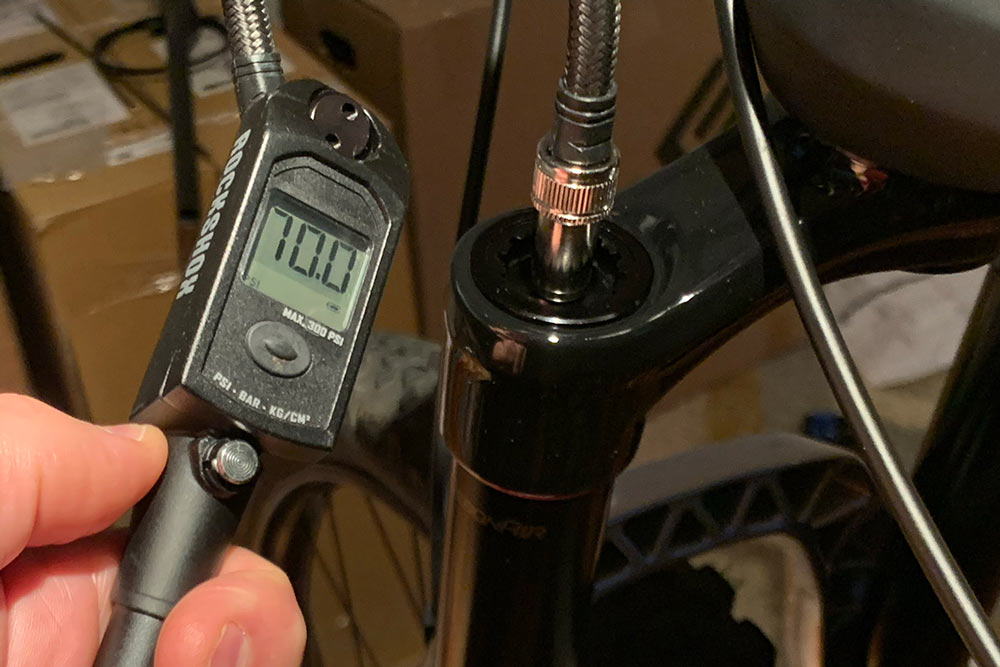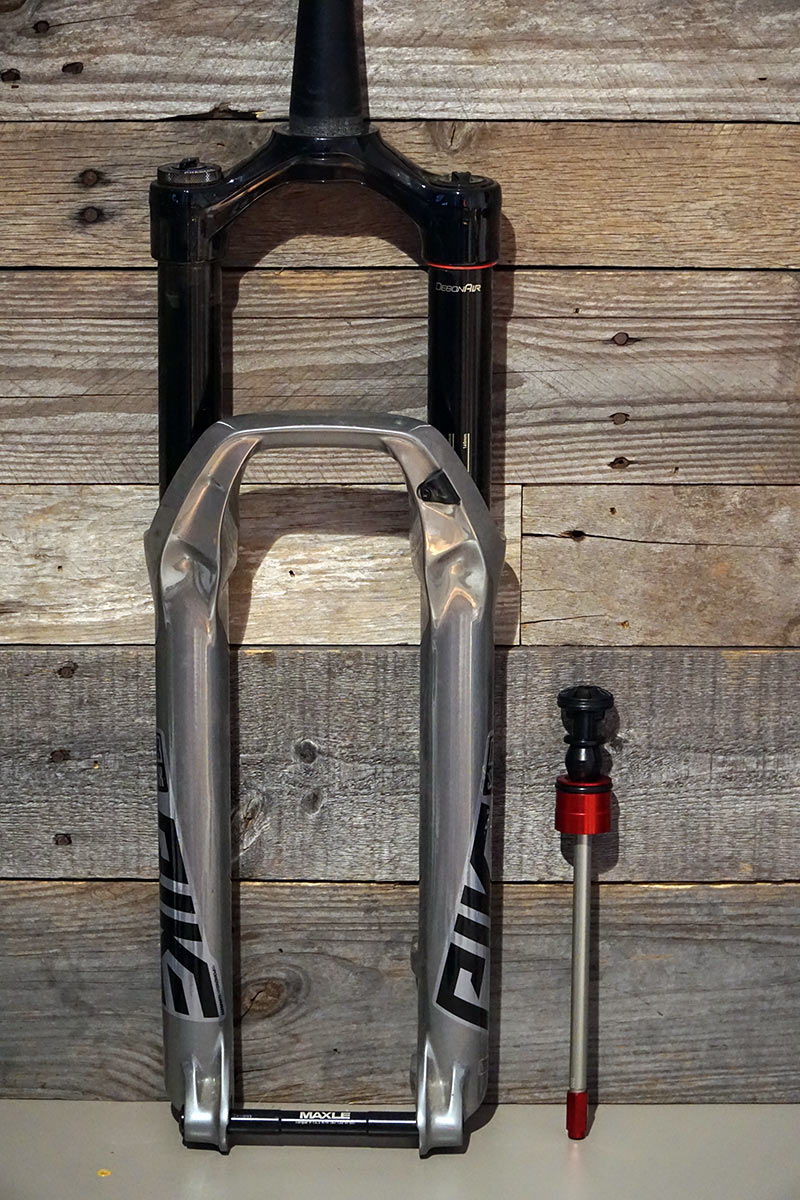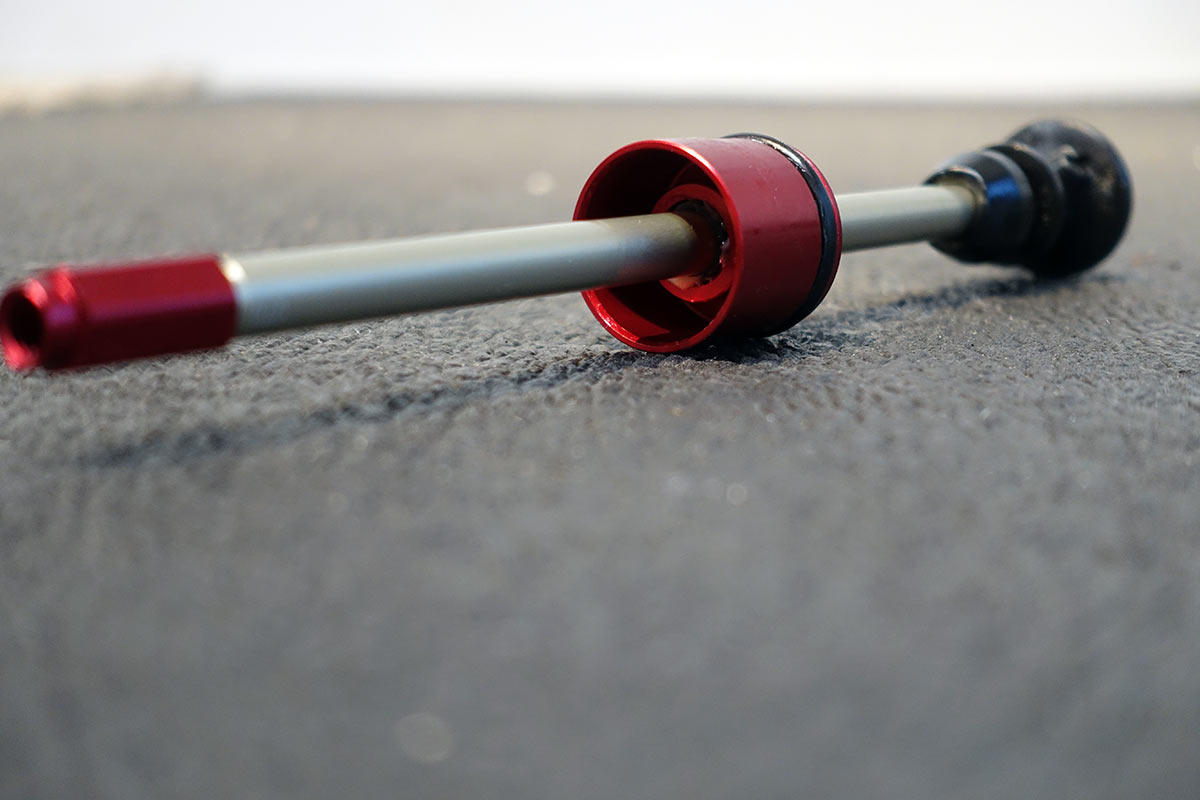Just last year, Rockshox overhauled all of their forks with improved seals, grease and other refinements to reduce friction and make everything smoother. Now, the DebonAir air spring gets a rework, helping the forks sit higher in their travel so that you get more useable travel. As a bonus, setup should be a lot easier now, too.
This new DebonAir air spring builds on the 2018 update that introduced a larger negative air chamber, helping improve small bump sensitivity. And that carries over here, it’s just that things have shifted upward slightly. Literally.
They simply shifted the piston’s starting point a little higher. So, how did that affect ride height, initial stroke, and set up? For that, we’ve gotta dive deep…
It’s the piston versus the dimple
To understand why this change matters, you have to understand how their forks worked prior to this. Inside the left leg of a Rockshox fork is the air spring. Inside that is an air piston that separates the positive chamber from the negative. That piston sat below a dimple.
Typically, you fill the positive air chamber to the desired pressure, remove the pump, then compress the fork a couple times so that the piston seal passes over that dimple and fills the negative air chamber, too.
Great, what’s the dimple?
The “dimple” is basically a small indent inside the stanchion that allows air to move from the positive chamber to the negative. Think of it as a check valve, or transfer port. When Rockshox did away with their dual-air forks years ago (those had two valves, for filling each chamber separately), the dimple is what let the forks equalize pressure between the two chambers…and this is how most suspension brands accomplish the same things on both forks and shocks.
More or less, when the fork was sagged, the piston would pass over the dimple frequently and maintain equal-ish air pressure between the two chambers…at sag height.
So what’s the problem? Why change it?
Actually, there are a couple problems with this design.
For starters, when you’re setting up the fork, you have to compress it a few times to get it to equalize the negative chamber. Which means you have to overinflate the positive chamber, remove the pump, compress it, reattach the pump and adjust the pressure. Keep doing that until it ends up where you want it.
There’s a lot of trial and error, and getting the air pressure exactly where you want it once is time consuming. Doing it repeatedly is a pain. But that’s not really why they changed it.
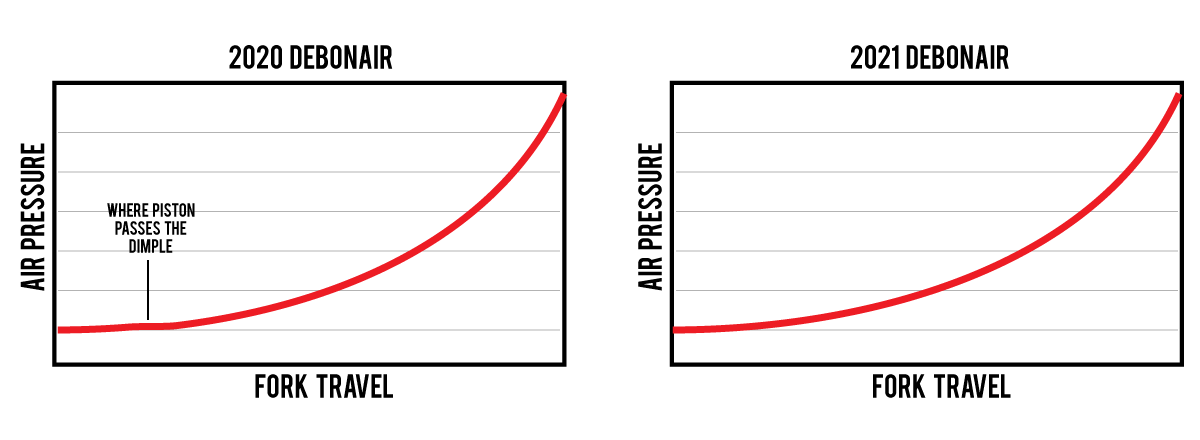
With the piston sitting below the dimple, you essentially had two different spring rates. The first happened before the piston reached the dimple, and the second happened after it passed by the dimple. Basically, it would start building pressure, then equalize (slight drop in positive chamber pressure), then start building up pressure again.
All of that happens in about the first 15mm of travel. Which, for a 150mm fork, is 10% of its travel.
The result was that the first ~20% of travel could feel really soft because it would build a tiny bit of pressure, then drop slightly and equalize the negative, then start building again. On the shop floor, that would feel good. And it helped make the fork feel really supple on small bumps. Which sounds good, right?
Unfortunately, it made it virtually impossible for Rockshox to control the spring rate for that first bit of travel because the pressure wouldn’t change in a predictable manner. So, they moved the piston higher to sit level with the dimple at top out.
This means that when you’re setting up your fork, both positive and negative air chambers are being filled simultaneously and equally. As soon as you get on the bike, your weight sags the fork, moving the piston above the dimple and sealing off the positive chamber from the negative chamber.
That eliminates the build-equalize-build cycle, which means a more supportive initial stroke. Or firmer, depending on how you look at it. More on that in a minute.
Why not just move the dimple?
Seems simple, right? The short answer: Because then this new DebonAir air spring wouldn’t be backwards compatible with all of their prior 35mm stanchion forks.
You can get this new DebonAir air spring kit for any prior Pike, Revelation, Lyrik or Yari fork and swap it in. Even better, they’re also offering a new foot nut/seal head combo so you can simply upgrade your current air spring without having to replace the whole piston assembly.
Foot Nut? Seal Head? WTF are those?
Here’s what you’re looking at:
A. Quad Ring (basically a fancy O-ring seal for the Air Piston)
B. Air Piston
C. Top Out Bumper
D. Air Shaft
E. Seal Head O-ring
F. Seal Head
G. Foot Nut
And here’s what they do: The Air Piston (A/B) separates the positive and negative chambers…it’s what pushes the air to compress the positive chamber when you hit a bump. The Top Out Bumper (C) keeps the hard parts from smashing into each other when the fork tops out, like when you catch some sweet air.
The Air Shaft (D) is what holds the piston and slides through the Seal Head. The Seal Head (E/F) is what seals off the bottom of the stanchion to create an airtight chamber for your air spring. The Foot Nut (G) is what attaches the assembly to the fork’s lowers. That bolt on the bottom of your fork leg? It threads into the Foot Nut.
How does this compare to the old DebonAir spring?
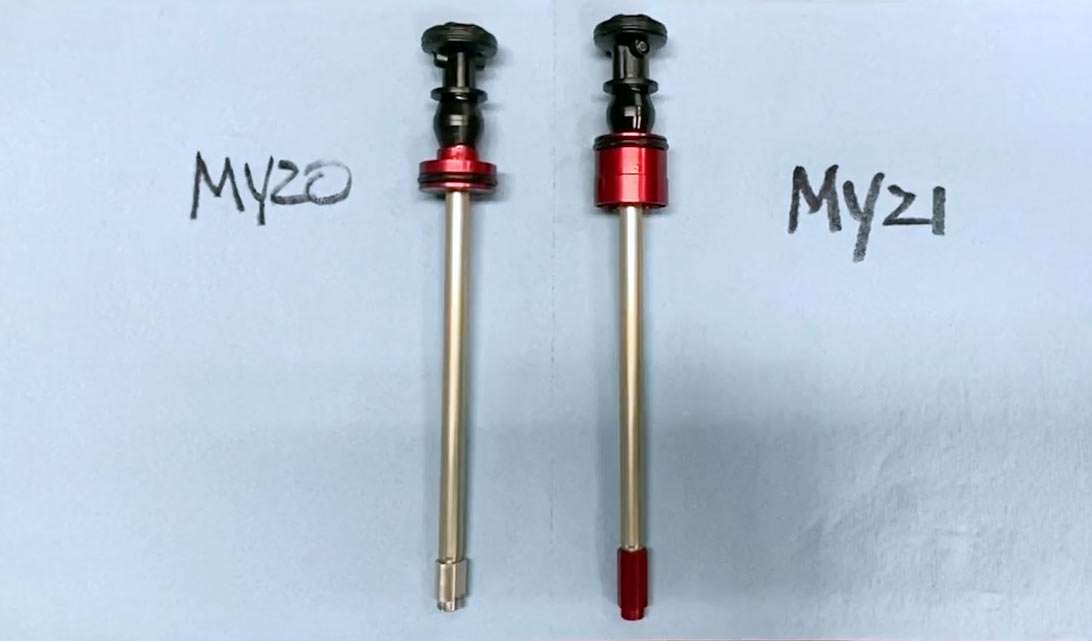
The only two differences from MY2020 DebonAir springs and MY2021 are the longer Foot Nut and taller Seal Head. Quite simply, it’s the taller Foot Nut that pushes the piston up higher to sit at the dimple.
But, that meant they had to change the Seal Head height in order to keep the negative chamber’s volume the same…and maintain the correct distance between the parts so the top out bumper would stop where it should. If you swapped only the Foot Nut, the fork would try to hyper extend during top out (also known as “negative travel”). No, don’t try it…it’s not a way to increase your fork’s travel. But it is a good way to break things.
The longer seal head at the bottom serves another purpose. Since its O-ring is essentially the bottom of your air spring and is what seals the air into the stanchion, it’s also sealing off the air space below it.
The space above it, all the way up to the piston’s seal, is your negative spring. The space below it? It’s essentially a secondary positive air chamber, albeit a non-pressurized one. And Rockshox has to calculate for this as part of the total positive air spring volume used to control the spring rate and bottom out.
And it’s the “bottom out” where this new, larger cushion of air comes into play. As the fork compresses, that lower air chamber compresses and builds pressure, too. Because it’s now larger than before, it doesn’t ramp up as hard. Which means it’s easier to use more (ideally all) of your travel, which is a topic other brands are tackling, too.
You might need to adjust your air pressure
Technically, the positive air spring volume decreased as the piston moved up. How much? About half of a Bottomless Token’s worth. So, not much. And the negative volume stayed the same.
Thus, the 2021 Lyrik and Yari have the same recommended air pressure settings. For Pike and Revelation, it’s 5psi less to account for the change in ratio between positive and negative. The Pike has a comparatively smaller negative-to-positive volume ratio than the Lyrik, so this new seal placement had a bigger effect on the Pike’s spring rate.
TL;DR
The new 2021 DebonAir air spring design makes it easier to set up your suspension fork by simultaneously filling both positive and negative air chambers. And it keeps the fork riding higher in its travel by better controlling the spring rate during the first 10-20% of travel. This helps you get more useable travel out of your fork, but it may feel just a little firmer at the beginning of its travel.
2021 Rockshox Pike, Revelation, Lyrik & Yari fork specs
The new DebonAir air spring comes stock inside the 2021 Pike, Revelation, Lyrik and Yari forks. All other features carry over from the 2020 models, and you can check out all that tech here. The new 2021 SID SL and SID Ultimate both get the same piston-to-dimple placement upgrade, but it’s based on an entirely new and different stanchion and lower and is not simply a new air spring.
Here are the key specs for each of these forks:
2021 Rockshox Pike
- 27.5″ and 29″
- Travel: 130mm / 140mm / 150mm
- Damper: Charger 2.1 RC2 (Pike Ultimate) or Charger RC (Pike Select)
- 37mm (27.5″), 46mm (27.5″), 42mm (29″), 51mm (29″)
- Pike Ultimate: $899 | €979 | £869
- Pike Select: $699 | €759 | £679
2021 Rockshox Revelation RC
- 27.5″ and 29″
- Travel: 120mm / 130mm / 140mm / 150mm
- Damper: Motion Control
- 46mm (27.5″), 42mm (29″)
- MSRP: $499 | €539 | £479
2021 Rockshox Lyrik
- 27.5″ and 29″
- Travel: 150mm / 160mm / 170mm / 180mm
- Damper: Charger 2.1 RC2 (Lyrik Ultimate) or Charger RC (Lyrik Select)
- 37mm (27.5″), 46mm (27.5″), 42mm (29″), 51mm (29″)
- Lyrik Ultimate: $949 | €1,039 | £929
- Lyrik Select: $749 | €819 | £729
2021 Rockshox Yari RC
- 27.5″ / 29″ / 29″+
- Travel: 130mm / 140mm / 150mm
- Damper: Motion Control
- 46mm (27.5″), 42mm (29″), 51mm (29″+)
- Pike Ultimate: $899 | €979 | £869
- Pike Select: $499 | €539 | £479
All prices include VAT. Some models will also offer a 44mm offset for OEM customers only. All forks available April 2020.


